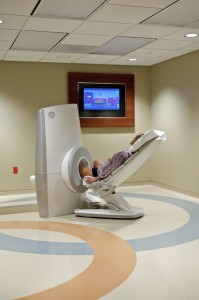March 6, 2020 by John Fernandez
MRI or CT Scan?

When doctors need to look inside your body to determine the cause of pain or abnormal symptoms, they typically order an imaging study.
Imaging studies generally include X-rays, ultrasounds, CT (or CAT) scans or MRIs.
The differences between X-rays and ultrasounds are somewhat common knowledge – X-rays use radiation and ultrasounds use sound waves to show organs and bones within the body. However, the differences between CTs and MRIs may not be so clear, especially since the machinery looks the same to the untrained eye.
According to the National Institutes of Health, MRI, or magnetic resonance imaging, uses strong magnets and radio waves to produce images of organs and structures within the body. Similarly, CT scans – known commonly as CAT scans – show internal organs and tissues, but use computed tomography (CT), a type of radiation-emitting X-ray, to produce the images, the NIH says.
So why one instead of the other?
Radiologist James Greve, M.D., who reads both CT scans and MRIs for Baptist Health hospitals and Baptist Medical Plazas, says that each technology offers advantages.
CT scans, he says, are best for a quick diagnosis. “When patients come into the emergency room with abdominal pain, for instance, we can take a look relatively quickly to determine the cause of that pain,” he said. “Most CTs are done in less than a minute, once the patient is properly positioned.”
For that quickness, Dr. Greve says, CT scans make better screening tools than MRIs.
They also pinpoint abnormal bleeding better than MRIs, so they are often used to confirm head trauma, stroke and internal bleeding.
MRIs, on the other hand, typically take about 45 minutes to complete. But, Dr. Greve points out that MRIs are better at finding soft-tissue injuries. That’s why people who injure their ligaments and cartilage, as often happens with many sports-related injuries, end up having an MRI.
Why both?
Don’t be surprised if your doctor orders a CT scan, followed by an MRI.
“These really are complementary technologies,” Dr. Greve said. “Doctors may order MRIs to further investigate an abnormal finding on a CT scan.” These abnormalities may include tumors or a broken bone that hasn’t become misaligned, or displaced.
Disadvantages?
Because CT machines use radiation to produce images, doctors avoid ordering this test for children, in most cases, and for pregnant women. Dr. Greve says that MRIs work as substitutes for these patients, yet more views may be needed, resulting in a longer test.
Not everyone can have MRIs either. The magnets in MRIs are so powerful that people with any type of metal in their bodies should not have an MRI. Dr. Greve points to pacemakers, aneurysm clips, steel or metal implants or shrapnel from previous injuries, as hazards that would prevent someone from having an MRI. These can move with the magnetic force and cause internal injuries.
What about claustrophobia?
Open MRIs and large-bore varieties of MRI machines and CT scanners help patients overcome feelings of claustrophobia. Also, added comfort measures such as headphones and rearview mirrors in the machines help people feel less closed-in when they are put in the machines, especially for head or abdominal scans.
Other options?
Another type of MRI – the extremity MRI – offers those with arm or leg
 injuries an added level of comfort. Tony Blanco, director of imaging at Doctors Hospital says patients, especially those who have had traditional MRIs, rave about this new option. “Many patients are relieved to find out they’re just putting their injured limb inside this machine for the scan,” he said. “They sit back on a recliner and watch TV or listen to music. It’s great for people who might put off this test for definitive answers about their condition because they are claustrophobic and fear lying inside the tube of a regular MRI scanner for such a long period of time.”
injuries an added level of comfort. Tony Blanco, director of imaging at Doctors Hospital says patients, especially those who have had traditional MRIs, rave about this new option. “Many patients are relieved to find out they’re just putting their injured limb inside this machine for the scan,” he said. “They sit back on a recliner and watch TV or listen to music. It’s great for people who might put off this test for definitive answers about their condition because they are claustrophobic and fear lying inside the tube of a regular MRI scanner for such a long period of time.”
Dr. Greve says no matter what type of imaging test you need, the best way to get the clearest image is to stay completely still when the technologist tells you to. Having recently had an MRI himself, he understands that challenge. But, he adds that in the reading room, when he’s looking for abnormalities on these scans, it makes all the difference.
top stories












There are no comments